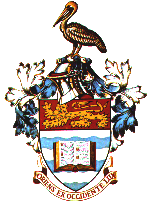![]()
![]()
![]()
![]()
![]()
MUTATION

![]()
![]()
![]()
![]()
![]()
MUTATION
We will continue this by looking at briefly examples of the various types.
original DNA sequence:
5'CAT CAT CAT CAT
3'GTA GTA GTA GTA
aa sequence: His His his his
Substitution
5'CAT CAT TAT
CAT
3'GTA GTA ATA
GTA
his his
tyr his
Addition
5'CAT CAT GCA
TCA T
3'GTA GCA
CGT AGT A
His
his
ala ser
ser
Deletion
5'CAT CAC
ATC AT
3'GTA GTG
TAG TA
His his
ile ile
These all classify as point mutations - mutations in a nucleotide pair. These are also missense mutations as they result in the incorporation of a different amino acid. Additions and deletions lead to frameshift mutations - change in the reading frame of the mRNA.
Reverse mutations
These mutations can all be classified as forward mutations. A Reverse or back mutations can take two forms: a true reverse mutation or reversion which produces the original DNA sequence or a suppressor mutation which is a second foward mutation resulting in wild type or almost wild type phenotype (or restore normal function) in the double mutants. E.g. a second foward mutation such as an addition followed by a deletion. This restores the reading frame.
(Insert G) G (delete T) T
CAT CAT GCA
TCA CAT CAT
GTA GTA CGT
AGT GTA GTA
- also called an intragenic suppressor. If the altered amino acids were not critical to function of the protein (e.g. DNA binding, protein folding) then the resulting protein may have normal functionality.
However, suppression can occur at a number of levels. For example, the second mutation can be within a tRNA gene so that the mutant codon can be correctly coded for. This is seen in the tRNA suppression of nonsense mutations.
E.g.
normal sequence in DNA
mutant sequence
5'TCG TCG
TCG
TCG TAG TCG
3'AGC AGC
AGC
AGC ATC AGC
mRNA
(Transversion)
3'UCG UCG
UCG
UCG UAG UCG
Ser
ser ser
Ser amber
Nonsense codon
The amber termination codon causes early termination of transcription and a non-functional protein is produced.
A second mutation in a tRNA gene may produce a tRNA with an anticodon 3'AUC which could mobilise serine (or other aa) and this would be a nonsense suppressor, specifically an amber suppressor, and the normal protein function could be restored.
E.g. in E. coli there is a tRNA gene carrying AUC the anticodon that will suppress UAG amber mutations by inserting tyrosine in the polypeptide chain. This is another example of suppression.
Suppressor mutations can be distinguished by reversions in genetic crosses as a reversion is at the same site in the genome as the original mutation while suppressor is at a different site in the genome. If a suppressor mutation is crossed with a wild type in a haploid organism, then the original forward mutation can reappear in the progeny.
Fig
This is an example where the original and suppressor mutations are on a different chromosome (in trans), but even if the mutations are in cis, they can be separated by recombination in a subsequent cross and the original mutation will reappear in the progeny.
In a true reversion, though, the DNA is restored to the original wild type sequence and the original mutation cannot reappear during a subsequent crossing (except by repetition of the mutation).
There are methods of staining chromosomes so that some regions take up more stain than others. This is referred to as chromosome banding - differential staining along the longitudinal axis - e.g. C-banding with Giemsa stain, Q-banding with fluorescent dues that bind to nucleoprotein complexes. This allows effects of chromosomal mutations to be observed.
duplication
inversion
deletion
translocation
reciprocal translocation
e.g. Polyploidy
diploidy. Triploidy, tetraploidy etc
modern cultivars of wheat are hexaploid
there is also allopolyploidy - a polyploid condition resulting from the combination of genetically distinct chromosome sets of different species or varieties.
Aneuploidy - chromosome number of an individual is not an exact multiple of the typical haploid set for the species e.g. 2n+1 would be hyperdiploid and trisomic for a particular chromosome. Down's syndrome in humans is trisomy 21.
(in fact all that is necessary for Down's syndrome is for cells to have 3 copies of a specific region of the long arm of chromosome 21.)
Other aneuploid types:
hypodiploid: e.g. 2n-1, i.e. monosomic for one chromosome
there are thus possible a variety of aneuploids: 2n±1, 2, 3 etc
In haploid organisms:
n+1 is hyperhaploid
and disomic for one chromosome.
n-1 is hypohaploidand nullisomic for one chromosome. This is usually lethal as with many aneuploid states
In diploid organisms autoploidy and aneuploidy result from breakdown of the normal cell division process. If chromosomes duplicate but fail to separate then polyploidy can result.
- If, in meiosis, one chromosome pair fails to separate, aneuploidy results leading to one hyperhaploid and one hypohaploid daughter cell.
- If these hyperhaploid and hypohaploid gametes fuse with normal gametes
then the progeny are hyperdiploid and hypodiploid, respectively.
This template created by the Web Diner.